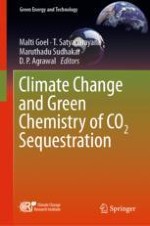2021 | OriginalPaper | Chapter
Research & Development Pathways/Challenges in Direct Air Capture of CO2
Author : Gautam Sen
Published in: Climate Change and Green Chemistry of CO2 Sequestration
Publisher: Springer Singapore
Activate our intelligent search to find suitable subject content or patents.
Select sections of text to find matching patents with Artificial Intelligence. powered by
Select sections of text to find additional relevant content using AI-assisted search. powered by
